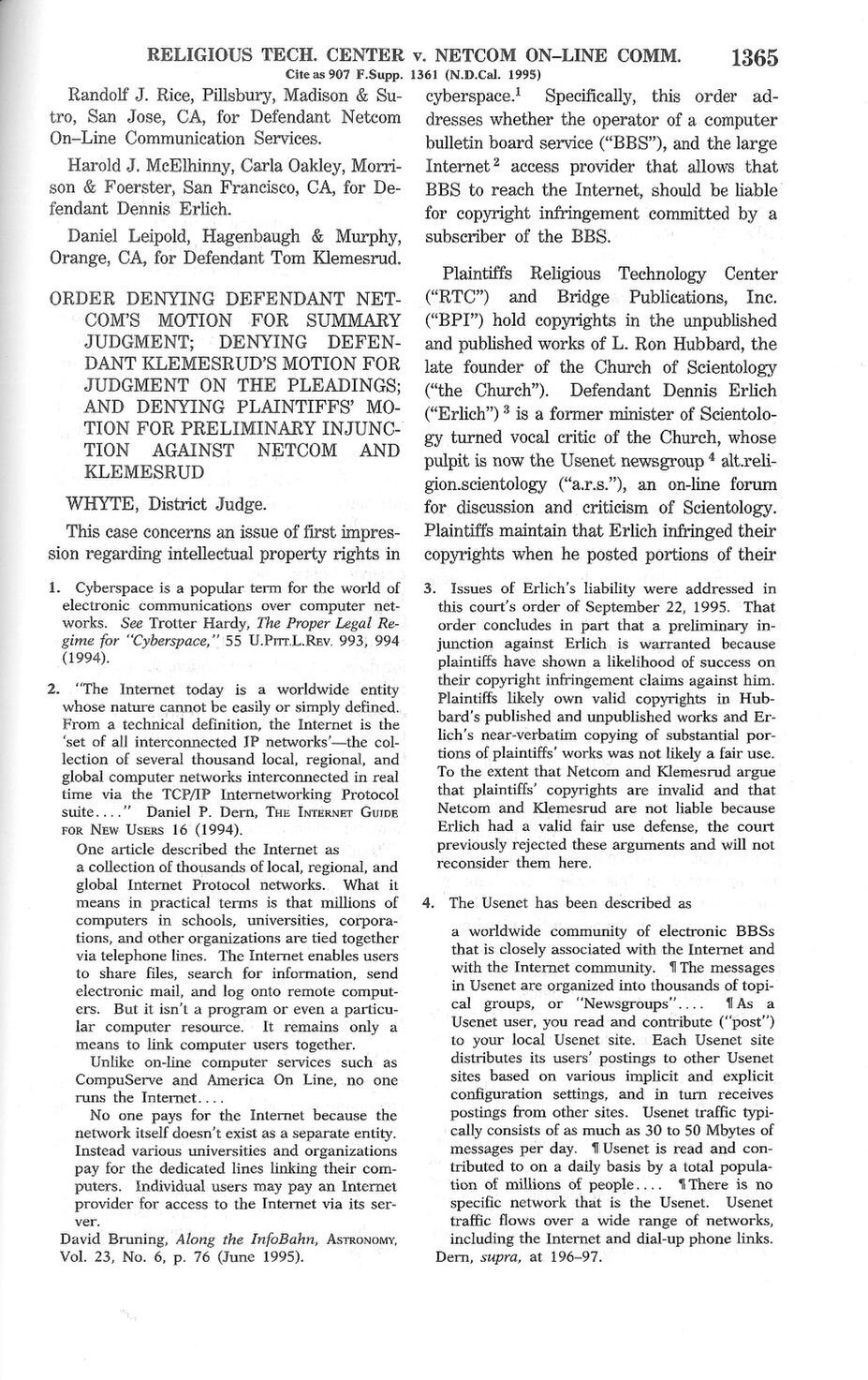Cite as 907 F.Supp. 1361 (N.D.Cal. 1995)
Randolf J. Rice, Pillsbury, Madison & Sutro, San Jose, CA, for Defendant Netcom On-Line Communication Services.
Harold J. MecElhinny, Carla Oakley, Morrison & Foerster, San Francisco, CA, for Defendant Dennis Erlich.
Daniel Leipold, Hagenbaugh & Murphy, Orange, CA, for Defendant Tom Klemesrud.
WHYTE, District Judge.
This case concerns an issue of first impression regarding intellectual property rights in cyberspace.[1] Specifically, this order addresses whether the operator of a computer bulletin board service (“BBS”), and the large Internet[2] access provider that allows that BBS to reach the Internet, should be liable for copyright infringement committed by a subscriber of the BBS.
Plaintiffs Religious Technology Center (“RTC”) and Bridge Publications, Inc. (“BPI”) hold copyrights in the unpublished and published works of L. Ron Hubbard, the late founder of the Church of Scientology (“the Church”). Defendant Dennis Erlich (“Erlich”)[3] is a former minister of Scientology turned vocal critic of the Church, whose pulpit is now the Usenet newsgroup[4] alt.religion.scientology (“a.r.s.”), an on-line forum for discussion and criticism of Scientology. Plaintiffs maintain that Erlich infringed their copyrights when he posted portions of their
- ↑ Cyberspace is a popular term for the world of electronic communications over computer networks. See Trotter Hardy, The Proper Legal Regime for “Cyberspace,” 55 U.Pitt.L.Rev. 993, 994 (1994).
- ↑ “The Internet today is a worldwide entity whose nature cannot be easily or simply defined. From a technical definition, the Internet is the ‘set of all interconnected IP networks’—the collection of several thousand local, regional, and global computer networks interconnected in real time via the TCP/IP Internetworking Protocol suite….” Daniel P. Dern, The Internet Guide for New Users 16 (1994).
One article described the Internet as
a collection of thousands of local, regional, and global Internet Protocol networks. What it means in practical terms is that millions of computers in schools, universities, corporations, and other organizations are tied together via telephone lines. The Internet enables users to share files, search for information, send electronic mail, and log onto remote computers. But it isn’t a program or even a particular computer resource. It remains only a means to link computer users together.
Unlike on-line computer services such as CompuServe and America On Line, no one runs the Internet….
No one pays for the Internet because the network itself doesn’t exist as a separate entity. Instead various universities and organizations pay for the dedicated lines linking their computers. Individual users may pay an Internet provider for access to the Internet via its server.
David Bruning, Along the InfoBahn, Astronomy, Vol. 23, No. 6, p. 76 (June 1995).
- ↑ Issues of Erlich’s liability were addressed in this court’s order of September 22, 1995. That order concludes in part that a preliminary injunction against Erlich is warranted because plaintiffs have shown a likelihood of success on their copyright infringement claims against him. Plaintiffs likely own valid copyrights in Hubbard’s published and unpublished works and Erlich’s near-verbatim copying of substantial portions of plaintiffs’ works was not likely a fair use. To the extent that Netcom and Klemesrud argue that plaintiffs’ copyrights are invalid and that Netcom and Klemesrud are not liable because Erlich had a valid fair use defense, the court previously rejected these arguments and will not reconsider them here.
- ↑ The Usenet has been described as
a worldwide community of electronic BBSs that is closely associated with the Internet and with the Internet community. ¶The messages in Usenet are organized into thousands of topical groups, or “Newsgroups” …. ¶As a Usenet user, you read and contribute (“post”) to your local Usenet site. Each Usenet site distributes its users’ postings to other Usenet sites based on various implicit and explicit configuration settings, and in turn receives postings from other sites. Usenet traffic typically consists of as much as 30 to 50 Mbytes of messages per day. ¶Usenet is read and contributed to on a daily basis by a total population of millions of people…. ¶There is no specific network that is the Usenet. Usenet traffic flows over a wide range of networks, including the Internet and dial-up phone links.
Dern, supra, at 196–97.
